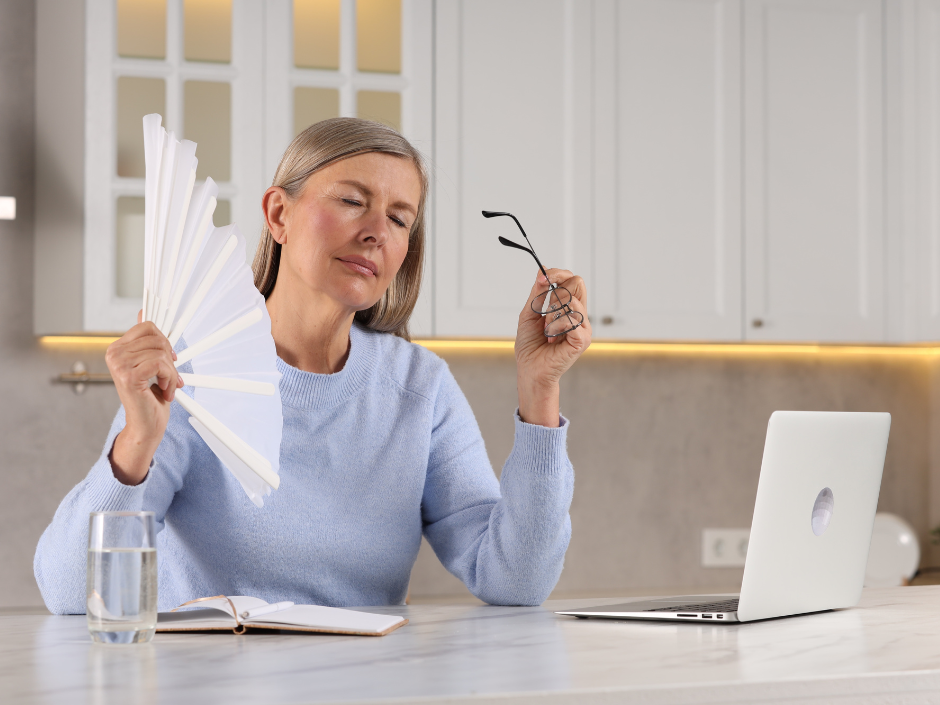Managing Hot Flushes in Perimenopause
- Gemma Knaap
- Aug 4
- 3 min read

Hot flushes are one of the most common — and often disruptive — symptoms of perimenopause and menopause. But while they’re frequently blamed on “low oestrogen,” the real story is a little more complex. Understanding what’s actually happening in the body can help you feel more empowered to manage hot flushes and support your long-term health, regardless of whether or not you choose hormone therapy.
What Causes Hot Flushes?
It’s true that oestrogen plays a role, but hot flushes don’t begin in the ovaries — they begin in the brain. Specifically, the hypothalamus acts as the body’s thermostat, keeping core temperature within a narrow range. During perimenopause, as oestrogen begins to fluctuate and decline, this thermostat becomes more sensitive. Even small changes in temperature — or stress — can trigger a hot flush.
Serotonin, a key neurotransmitter, also plays a role in temperature regulation. Because oestrogen helps modulate serotonin, hormonal shifts can lead to disruptions in both temperature control and mood. This is why flushes, anxiety, and poor sleep often show up together.
Flushes can feel different from person to person. Some women feel a rising heat and sweating; others feel anxious, flushed, wired, or even chilled afterwards. Night sweats may be especially disruptive, affecting not just comfort but overall sleep quality and resilience.
It’s also worth noting that not all women experience hot flushes. Genetics, metabolic health, smoking, alcohol use, gut health and stress all influence how your body copes with the hormonal changes of perimenopause.
The good news? There are evidence-based ways to support your body through this process — with or without HRT.
What Actually Helps?
Because hot flushes are driven by the nervous system and brain chemistry, long-term support goes beyond simply replacing hormones. Here are some of the most effective ways to reduce flushes naturally:
1. Balance blood sugar
When your blood sugar drops, it triggers a stress response — and that can bring on a flush. Eating regularly, balancing meals with protein, healthy fats and fibre, and avoiding caffeine or alcohol on an empty stomach can help keep things stable.
2. Support your nervous system
The more reactive your nervous system, the more likely you are to flush. Daily stress regulation practices — like deep breathing, gentle walking, or grounding rituals — can make a real difference. These don’t have to be big changes, but they do need to be consistent.
3. Improve sleep quality
Night sweats are a major disruptor. Try sleeping in a cool, dark room, use layers that can be adjusted through the night, and develop a calming wind-down routine that reduces screen time and lowers cortisol before bed.
4. Identify and manage triggers
Common triggers include alcohol, spicy food, smoking, emotional stress, and overheating. Every woman is different, so it helps to track your patterns and identify what sets things off for you.
5. Support with food and herbs
Magnesium-rich foods, B vitamins, flaxseeds and lentils can all support hormone metabolism and temperature regulation. Herbs like sage, black cohosh and shatavari have shown promise, but individualised care matters here — not every herb is right for everyone.
6. Don’t overlook foundational support — even with HRT
Hormone therapy can be very helpful for some women, especially if flushes are severe. But it works best when combined with good nutrition, nervous system regulation and lifestyle support. These strategies help improve overall resilience, sleep, cardiovascular health and long-term wellbeing — whether or not you're using hormones.
The Bottom Line
Hot flushes are a sign that your body is adjusting to a new hormonal rhythm. They’re not just caused by oestrogen decline — they involve brain chemistry, nervous system sensitivity and individual triggers. With the right strategies and support, hot flushes can become far more manageable — and often improve over time. You don’t have to put up with them, and you don’t have to navigate this alone.
For personalised support with perimenopause symptoms, or to explore options including herbal support, you can book a 1:1 consultation online.




Comments